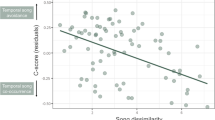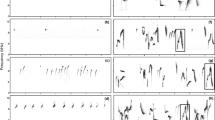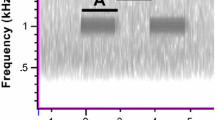Abstract
Many songbird species have evolved multiple vocalizations, or repertoires, that function to communicate various biological signals. More diverse repertoires may have evolved in response to the effects of seasonal variation in habitat structure on signal transmission. Such changes in habitat necessarily occur for migrating species, but they also occur for resident species that occupy deciduous forests. The black-capped chickadee (Poecile atricapillus) possesses a chick-a-dee call and a fee-bee song, but the closely related boreal chickadee (P. borealis) lacks a song. Consistent with the habitat variability hypothesis, the black-capped chickadee possesses a larger repertoire and primarily occupies deciduous forests, whereas the songless boreal chickadee occurs more often in coniferous forests. We explored the ecological basis of this hypothesis by recording audio playbacks of two species in two habitat types during two seasons. Specifically, we played both songs and calls of the black-capped chickadee and calls of the boreal chickadee in deciduous and coniferous habitats, prior to and after leaf-out. We measured attenuation and degradation in re-recorded vocalizations. For black-capped chickadees, the song was less degraded than the call in post-leaf, deciduous forests. The boreal chickadee call attenuated more quickly in all treatments, but maintained its acoustic structure better than both black-capped chickadee vocalizations in coniferous forests. Our results support the hypothesis that variable habitats provided a seasonal transmission benefit for both song and call in the black-capped chickadee, but that the transmission benefit of song is lost in the less variant coniferous forests, which may underlie the absence of a song in the boreal chickadee.




Similar content being viewed by others
References
Airey DC, Buchanan KL, Szekely T, Catchpole CK, DeVoogd TJ (2000) Song, sexual selection, and a song control nucleus (HVC) in the brains of European sedge warblers. J Neurobiol 44(1):1–6
Avey MT, Quince AF, Sturdy CB (2007) Seasonal and diurnal patterns of black-capped chickadee (Poecile atricapillus) vocal production. Behav Process 77(2):149–155. doi:10.1016/j.beproc.2007.12.004
Beeman K (2009) Signal reference guide. Version 4.04.29/5.04.29. Engineering Design, Berkeley
Benninghoff WS (1966) The relevé method for describing vegetation. Mich Bot 5:109–114
Boncoraglio G, Saino N (2007) Habitat structure and the evolution of bird song: a meta-analysis of the evidence for the acoustic adaptation hypothesis. Funct Ecol 21:134–142. doi:10.1111/j.1365-2435.2006.01207.x
Brenowitz EA (1982) The active space of red-winged blackbird song. J Comp Physiol A 147(4):511–522. doi:10.1007/BF00612017
Brown TJ, Handford P (2000) Sound design for vocalizations: quality in the woods, consistency in the fields. Condor 102:81–92
Buchanan KL, Catchpole CK (1997) Female choice in the sedge warbler Acrocephalus schoenobaenus multiple cues from song and territory quality. Proc Roy Soc B Biol Sci 264(1381):521–526
Burnham KP, Anderson D (2002) Model selection and multimodel inference: a practical information-theoric approach. Springer, New York
Catchpole CK, Slater PJB (2008) Bird song: biological themes and variations. Cambridge University Press, Cambridge
Charrier I, Bloomfield LL, Sturdy CB (2004) Note types and coding in parid vocalizations. I: the chick-a-dee call of the black-capped chickadee (Poecile atricapillus). Can J Zool 82:769–779
Christie PJ, Mennill DJ, Ratcliffe LM (2004) Pitch shifts and song structure indicate male quality in the dawn chorus of black-capped chickadees. Behav Ecol Sociobiol 55(4):341–348. doi:10.1007/s00265-003-0711-3
Dabelsteen T, Larsen ON, Pedersen SB (1993) Habitat-induced degradation of sound signals: quantifying the effects of communication sounds and bird location on blur ratio, excess attenuation, and signal-to-noise ratio in blackbird song. J Acoust Soc Am 93(4):2206–2220. doi:10.1121/1.406682
Dahlsten DL, Brennan LA, McCallum DA, Gaunt SL (2002) Chestnut-backed chickadee (Poecile rufescens). In: Rodewald PG (ed) The birds of North America. Cornell Lab of Ornithology, Ithaca; Retrieved from the Birds of North America. https://birdsna.org/Species-Account/bna/species/chbchi. doi:10.2173/bna.689
Ficken MS, Nocedal J (1992) Mexican chickadee (Poecile sclateri). In: Rodewald PG (ed) The birds of North America. Cornell Lab of Ornithology, Ithaca; Retrieved from the Birds of North America. https://birdsna.org/Species-Account/bna/species/mexchi. doi:10.2173/bna.8
Ficken MS, Ficken RW, Witkin SR (1978) Vocal repertoire of the black-capped chickadee. Auk 1:34–48. doi:10.2307/4085493
Ficken MS, McLaren MA, Hailman JP (1996) Boreal chickadee (Poecile hudsonicus). In: Rodewald PG (ed) The birds of North America. Cornell Lab of Ornithology, Ithaca; Retrieved from the Birds of North America. https://birdsna.org/Species-Account/bna/species/borchi2. doi:10.2173/bna.254
Foote JR, Mennill DJ, Ratcliffe LM, Smith SM (2010) Black-capped Chickadee (Poecile atricapillus). In: Rodewald PG (ed) The birds of North America. Cornell Lab of Ornithology, Ithaca; Retrieved from the Birds of North America. https://birdsna.org/Species-Account/bna/species/bkcchi. doi:10.2173/bna.39
Forrest TG (1994) From sender to receiver: propagation and environmental effects on acoustic signals. Am Zool 34(6):644–654. doi:10.1093/icb/34.6.644
Garamszegi LZ, Eens M (2004) Brain space for a learned task: strong intraspecific evidence for neural correlates of singing behavior in songbirds. Brain Res Rev 44(2–3):187–193. doi:10.1016/j.brainresrev.2003.12.001
Gil D, Gahr M (2002) The honesty of bird song: multiple constraints for multiple traits. Trends Ecol Evol 17(3):133–141. doi:10.1016/S0169-5347(02)02410-2
Gill FB, Slikas B, Sheldon FH (2005) Phylogeny of titmice (Paridae): II. species relationships based on sequences of the mitochondrial cytochrome-B gene. Auk 122(1):121–143. doi:10.1642/0004-8038(2005)122[0121:POTPIS]2.0.CO;2
Hadley A, Desrochers A (2008) Winter habitat use by boreal chickadee flocks in a managed forest. Wilson J Ornithol 120:139–145
Hailman JP (1989) The organization of major vocalizations in the Paridae. Wilson Bull 101(2):305–343
Hailman JP, Haftorn S (1995) Gray-headed chickadee (Poecile cinctus). In: Rodewald PG (ed) The birds of North America. Cornell Lab of Ornithology, Ithaca; Retrieved from the Birds of North America. https://birdsna.org/Species-Account/bna/species/gyhchi. doi:10.2173/bna.196
Hoeschele M, Moscicki MK, Otter KA, van Oort H, Fort KT, Farrell TM, Lee H, Robson SWJ, Sturdy CB (2009) Dominance signalled in an acoustic ornament. Anim Behav 79(3):657–664. doi:10.1016/j.anbehav.2009.12.015
Horn AG, Leonard ML, Ratcliffe L, Shackleton SA, Weisman RG (1992) Frequency variation in songs of black-capped chickadees (Parus atricapillus). Auk 109(4):847–852
Johnson MD, Sherry TW, Strong AM, Medori A (2005) Migrants in Neotropical bird communities: an assessment of the breeding currency hypothesis. J Anim Ecol 74(2):333–341
Krebs JR (1976) Habituation and song repertoires in the great tit. Behav Ecol Sociobiol 1(2):215–227. doi:10.1007/BF00299198
Krebs JR (1977) The significance of song repertoires: the Beau Geste hypothesis. Anim Behav 25:475–478. doi:10.1016/0003-3472(77)90022-7
Krebs JR, Kroodsma DE (1980) Repertoires and geographical variation in bird song. Adv Stud Behav 11:143–177
Krebs J, Ashcroft R, Webber M (1978) Song repertoires and territory defense in the great tit. Nature 271:539–542. doi:10.1038/271539a0
Kunc HP, Amrhein V, Naguib M (2005) Acoustic features of song categories and their possible implications for communication in the common nightingale (Luscinia megarhynchos). Behaviour 142(8):1077–1091
Lait LA, Burg TM (2013) When east meets west: population structure of a high-latitude resident species, the boreal chickadee (Poecile hudsonicus). Heredity 111(4):321–329
MacDonald IF, Kempster B, Zanette L, MacDougall-Shackleton SA (2006) Early nutritional stress impairs development of a song-control brain region in both male and female juvenile song sparrows (Melospiza melodia) at the onset of song learning. Proc Roy Soc B Biol Sci 273:2559–2564. doi:10.1098/rspb.2006.3547
Marten K, Marler P (1977) Sound transmission and its significance for animal vocalization. Behav Ecol Sociobiol 2:271–290
Maynard-Smith J, Harper D (2003) Animal signals. Oxford University Press, New York
McCallum DA, Grundel R, Dahlsten DL (1999) Mountain chickadee (Poecile gambeli). In: Rodewald PG (ed) The birds of North America. Cornell Lab of Ornithology, Ithaca; Retrieved from the Birds of North America. https://birdsna.org/Species-Account/bna/species/mouchi. doi:10.2173/bna.453
McLaren MA (1975) Breeding biology of the boreal chickadee. Wilson Bull 87(3):344–354
McLaren MA (1976) Vocalizations of the boreal chickadee. Auk 93(3):451–463
Mennill DJ, Ratcliffe LM, Boag PT (2002) Female eavesdropping on male song contests in songbirds. Science 296(5569):873. doi:10.1126/science.296.5569.873
Morton ES (1975) Ecological sources of selection on avian sounds. Am Nat 109:17–34. doi:10.1086/282971
Moscicki MK, Hoeschele M, Bloomfield LL, Modanu M, Charrier I, Sturdy CB (2011) Note types and coding in Parid vocalizations: the chick-a-dee call of the boreal chickadee (Poecile hudsonicus). J Acoust Soc Am 129(5):3327–3340
Mostrum AM, Curry RL, Lohr B (2002) Carolina chickadee (Poecile carolinensis). In: Rodewald PG (ed) The birds of North America. Cornell Lab of Ornithology, Ithaca; Retrieved from the Birds of North America. https://birdsna.org/Species-Account/bna/species/carchi. doi:10.2173/bna.636
Mougeot F, Bretagnolle V (2000) Predation as a cost of sexual communication in nocturnal seabirds: an experimental approach using acoustic signals. Anim Behav 60:647–656. doi:10.1006/anbe.2000.1491
Nottebohm F (2005) The neural basis of birdsong. PLoS Biol 3(5):e164. doi:10.1371/journal.pbio.0030164
Nowicki S, Searcy W, Peters S (2002) Brain development, song learning and mate choice in birds: a review and experimental test of the “nutritional stress hypothesis”. J Comp Physiol A Sens Neural Behav Physiol 188(11):1003–1014. doi:10.1007/s00359-002-0361-3
Oberweger K, Goller F (2001) The metabolic cost of birdsong production. J Exp Biol 204:3379–3388
Patten MA, Rotenberry JT, Zuk M (2004) Habitat selection, acoustic adaptation, and the evolution of reproductive isolation. Evolution 58:2144–2155
Podos J, Huber SK, Taft B (2004) Bird song: the interface of evolution and mechanism. Annu Rev Ecol Evol Syst 35:55–87. doi:10.1146/annurev.ecolsys.35.021103.105719
Potvin DA, Crawford PW, MacDougall-Shackleton SA, MacDougall-Shackleton EA (2015) Song repertoire size, not territory location, predicts reproductive success and territory tenure in a migratory songbird. Can J Zool 93:627–633
Ratcliffe L, Weisman R (1985) Frequency shift in the fee bee song of the black-capped chickadee. Condor 87:555–556
Richards DG, Wiley RH (1980) Reverberations and amplitude fluctuations in the propagation of sound in a forest: implications for animal communication. Am Nat 115:381–399
Ritchison G (1995) Characteristics, use and possible functions of the perch songs and chatter calls of male common yellowthroats. Condor 97:27–38
Rohwer S, Hobson KA, Rohwer VG (2009) Migratory double breeding in Neotropical migrant birds. Proc Roy Soc B Biol Sci 106(45):19050–19055
Shutler D, Weatherhead PJ (1990) Targets of sexual selection: song and plumage of wood warblers. Evolution 44(8):1967–1977
Slabbekoorn H, Smith TB (2002) Habitat-dependent song divergence in the little greenbul: an analysis of environmental selection pressures on acoustic signals. Evolution 56:1849–1858
Smith SM (1997) Black-capped chickadee. Stackpole Books, Mechanicsburg
Smith DG, Reid FA (1979) Roles of the song repertoire in red-winged blackbirds. Behav Ecol Sociobiol 5(3):279–290. doi:10.1007/BF00293676
Vu ET, Mazurek ME, Kuo Y (1994) Identification of a forebrain motor programming network for the learned song of zebra finches. J Neurosci 14(11):6924–6934
Wiley RH, Richards DG (1978) Physical constraints on acoustic communication in the atmosphere: implications for the evolution of animal vocalizations. Behav Ecol Sociobiol 3(1):69–94. doi:10.1007/BF00300047
Wiley RH, Richards DG (1982) Adaptations for acoustic communication in birds: sound propagation and signal detection. In: Kroodsma DE, Miller EH (eds) Acoustic communication in birds, vol 1. Academic Press, New York, pp 131–181
Yasukawa K (1981) Song and territory defense in the red-winged blackbird. Auk 98(1):185–187
Yip DA, Bayne EM, Sólymos P, Campbell J, Proppe D (2017) Sound attenuation in forest and roadside environments: implications for avian point-count surveys. Condor 119(1):73–84. doi:10.1650/CONDOR-16-93.1
Acknowledgements
Research was conducted under protocols approved by the University of Alberta Animal Care and Use Committee: Biosciences (680901). Funding was provided by an NSERC Discovery Grant (CBS). We would like to thank several volunteers that assisted in field data collection. We are indebted to the editor and two anonymous reviewers whose suggestions greatly improved the manuscript.
Author information
Authors and Affiliations
Corresponding author
Rights and permissions
About this article
Cite this article
Apol, C.A., Sturdy, C.B. & Proppe, D.S. Seasonal variability in habitat structure may have shaped acoustic signals and repertoires in the black-capped and boreal chickadees. Evol Ecol 32, 57–74 (2018). https://doi.org/10.1007/s10682-017-9921-4
Received:
Accepted:
Published:
Issue Date:
DOI: https://doi.org/10.1007/s10682-017-9921-4




